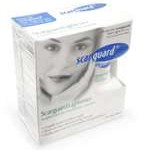Scars of some sort are the inevitable result after all plastic surgery procedures. Some scars are considerable in length and others are much smaller and more obscure. Regardless, they are of concern to all patients given the elective nature of the surgery. Most patients want to know how to take of a surgical scar so that it looks as obscure as possible. While the simple passage of time and healing of the wounded tissue plays a major role in the final appearance of a scar, there are some basic strategies I recommend in my Indianapolis plastic surgery practice to my patients. Employing these scar strategies can affect both the speed and final look of surgical scars.
Immediately after Surgery If your stitches are left open at the end of the operation, as would be most common in facial surgery, they should be keep covered with antibiotic ointment 2 to 3 times per day. The choice of antibiotic ointment is irrelevant. Contrary to what many believe, the purpose of the antibiotic ointment is to keep the sutures soft so that they are easier to remove. The antibiotic ointment probably has little effect on the risk of infection. Once the stitches are removed, it is not necessary to continue to apply the ointment.
Early Scar Therapy The beginning of actual scar treatment can begin when the surgical incision has gone through primary healing. This means that the outward skin surface of the incision is healed without any open areas. This does not mean that the entire scar has healed but that the outer skin layer (epithelium) is closed. The incision is sufficiently healed to start topical scar therapies. Generally, this is about 3 to 4 weeks after surgery.
While there are many topical scar creams and ointments, there are no studies that have ever compared any of these. Therefore, it is no possible to claim that any of them are necessarily better than any of the others. At the least, the use of any of them is probably better than not using any at all.

During this early scar phase, mild to moderate exposure to the sun may cause the scar to darken and become rougher in texture. Exposure to UV rays does not have a positive effect on the final look of scars, so it is crucial to protect them during outdoor activities. I recommend applying sunscreen with a dual SPF/SFA sun protection. These broad-spectrum sunscreens provide good scar protection.
Intermediate Scar Therapy In the first 3 to 6 months after surgery, scars are susceptible to pulsed or high-intensity light therapies. Known as IPL or BBL (broad band light) treatments, these quick and non-harmful light treatments may be effective at accelerating the removal of scar redness or softening the hard feeling of a scar. They can be done a week or two apart and it is usually best to do anywhere from 3 to 6 treatments depending upon how the scar is responding.
Late Scar Therapies After a year from surgery, no topical treatment or light therapy will have any effect on an unsightly scar. If the scar is raised, injections with steroids (Kenalog 10) may be tried and has a history of successful use. For scars that are wide or indented, however, surgical excision and reclosure will be the best strategy. (scar revision) If a scar is still red, treatment with a red photoselective laser (like for telangectasias and small veins) may be effective.
Dr. Barry Eppley
Indianapolis, Indiana


